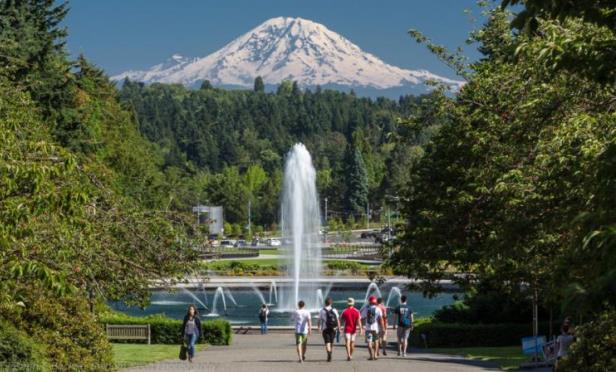 The Pacific Northwest has a good portion of universities, such as UW, achieving above-average rent growth.
The Pacific Northwest has a good portion of universities, such as UW, achieving above-average rent growth.
SEATTLE—Effective rent growth and year-over-year change in leasing velocity are key indicators of a university market's health. Staggering rent growth and no impact on leasing velocity illustrate strong fundamental health for many of the top-performing universities and the student housing properties surrounding them.
Overall rent growth for US student housing has compressed, going from 1.8% last fall to 1.4% this fall, but the range across many universities and individual assets is still wide. Peaks in new supply or supply and demand imbalances have caused moderation in performance this leasing season at many universities. But a steady flow of new supply and stable-to-strong enrollment growth has contributed better results for others.
New data from property management software provider RealPage revealed the top universities for rent growth in 2018. Among 120 universities assessed, 63% are achieving rental rate growth above the national average and nearly 30% of those have growth rates of 4% or more. At the same time, 50% of the universities had declines in year-over-year leasing velocity.
While the top-performing schools are fairly dispersed across the country, there are regional performance trends. The Midwest and Southwest have a higher percentage of universities with negative rent change. In the Southwest, this is because of the amount of new inventory delivered in recent years. In the Midwest, it's because of declining enrollment at some universities and sustained inventory growth.
The Mountain West and Pacific Northwest regions are seeing a good portion of universities achieve above-average rent growth. This is primarily because of limited supply and strong demand. GlobeSt.com learns that off-campus student housing properties near the University of Washington are averaging $1,098 per bed this fall, up 2.7% compared to last year. Rents are averaging between $840 and $1,470 per bed and the average pre-lease was 82% in June, down from more than 96% in June 2017, according to the study.
“These rents are considered top of the market relative to the national average (around $650 per bed) and relative to more mature student housing markets. However, it's in line with what we would expect in an urban university setting,” Taylor Gunn, director of student housing for Axiometrics, a RealPage company, tells GlobeSt.com. “We're seeing similar rent levels in Chicago, Atlanta, Philadelphia and Pittsburgh. In addition, a majority of the off-campus purpose-built stock at University of Washington was built between 2014 and 2017, which can also be contributing to the higher price points.”
Among the rent growth outperformers, Auburn University ranks number one with an average rental rate increase of 8%. This is above the three-year average of 5%. Mid-tier price points and moderate supply growth relative to enrollment growth of 2,700 off-campus beds versus enrollment growth of 4,700 students since 2011 has helped properties at Auburn to boost rents while continuing to have beds absorbed.
At number two Bowling Green State, no new supply this cycle coupled with low price points–below $400 per bed–has kept rent growth elevated the past few years. Rental rates have grown by an average of 5.5% the past three years and are currently above that level at nearly 7.9%.
The third-ranking University of Northern Colorado (6.4%) has also had minimal new supply, but stronger enrollment growth in 2016 and 2017 has helped to further drive rental rates above the three-year average of 1.3%.
University of Nevada–Reno has remained one of the top rent growth universities for three consecutive years. However, the rate of growth at Reno has moderated from three-year average of 9% to 5.8% this fall, which landed the university at number four. Little new supply and steady enrollment growth will help student properties continue to push rates.
Virginia Tech at number five and the University of Nebraska–Lincoln at number eight are the only universities reporting declines in year-over-year leasing velocity. Virginia Tech has remained a top performer in terms of prelease and rent growth for several consecutive years.
University of Nebraska–Lincoln has different story. The substantial inventory growth in this cycle–more than 200% increase–caused the market softened as existing properties struggled to be absorbed. But, the market has since started to recover and achieve above-average performance. For both universities, limited supply and positive growth expectations will play a role in maintaining absorption.
San Diego State, at number seven on the list, has the highest effective rent of the universities on the list, averaging more than $800 per bed. This price point is not abnormal for the region, but the rate growth of 5% is above what many other universities are reporting. This can be attributed to strong enrollment growth and minimal supply in the market, which captures less than 30% of existing students, the report indicates.
© Touchpoint Markets, All Rights Reserved. Request academic re-use from www.copyright.com. All other uses, submit a request to [email protected]. For more inforrmation visit Asset & Logo Licensing.







